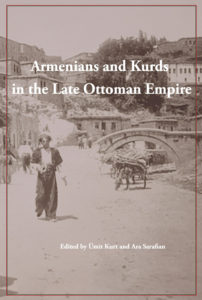
Staff Report
Prof. Barlow Der Mugrdechian, Berberian Coordinator of the Armenian Studies Program, announced that a ground-breaking new book, Armenians and Kurds in the Later Ottoman Empire, has been published by the Armenian Series of The Press, at California State University, Fresno. Armen-ians and Kurds is volume 9 in the Armenian Series and is number 1 in the Armenian Studies Program Conference Series.
Armenians and Kurds in the Later Ottoman Empire has five original articles, which were first presented at a conference entitled “Armenians, Greeks, and Kurds: A People’s History of the Ottoman Empire” organized by Prof. Barlow Der Mugrdechian of the Armenian Studies Program and by Dr. Ümit Kurt. The conference was held at Fresno State on September 22-23, 2017 and was supported by a grant from the Thomas A. Kooyumjian Family Foundation.
The book, edited by Ara Sarafian and Dr. Ümit Kurt, is a seminal work in the field of Ottoman history. The volume ex-plores the relationship between Turks, Armenians, and Kurds, and brings a new understanding to the dynamics that shaped these interactions.
The first three articles focus on the Hamidian massacres of 1895-96. They track societal changes to better explain the Hamidian massacres in Cilicia, Aintab, and the bishoprics of Aghtamar. Owen Miller, in the first article, “Uplands, Lowlands, and Mass Violence in Ottoman Cilicia,” looks at Ottoman Cilicia, with a particular focus on Zeitun. Ümit Kurt’s “The Breakdown of a Previously Peaceful Coexistence: The Aintab Armenian Massacres of 1895,” looks at major changes in material conditions and the availability of communal resources over the course of the 19th century. In his article, “In the Wake of the Aghtamar Catholicosate’s Demise: The Report on the 1895 Van Massa-cre by the Last Aghtamar Catholicos Khachadour II,” Emre Can Dağlıoğlu argues that the Hamidian massacres in this region were directly related to the breakup of longstanding Kurdish-Armenian social relations.
Nilay Özok-Gündoğan’s work is of seminal importance to the understanding of Armenian history and broader histories of the Middle East. Her article, “Are the Voices of the Ordinary Kurds Salvageable from the Enormous Condescension of Posterity? An Agenda for Social History in Kurdish Historical Writings,” reflects on the methodical ex-clusion of Kurds in mainstream historiographies of the Middle East.
Varak Ketsemanian’s work, “Ideologies Paradoxes, and Fedayis in the Late Ottoman Empire: Historiographical Chal-lenges and Methodological Problems in the Study of the Ar-menian Revolutionary Movement (1890–1896),” is an important critique of the historiography defining the Armenian revo-lutionary movement in the late Ottoman period.
Armenians and Kurds in the Later Ottoman Empire will be available, after June 1, through Amazon or by contacting the Armenian Studies Program.
 Hye Sharzhoom Armenian Action
Hye Sharzhoom Armenian Action